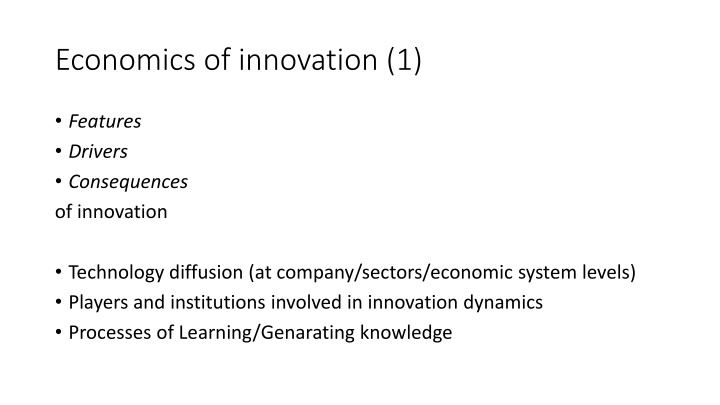
Key Elements of Innovation in Economic Thought and Practice
Explore the dynamics of innovation in economics, including drivers, consequences, technology diffusion, and the involvement of various players and institutions. Learn about the key steps in economic thought on innovation from influential figures like Adam Smith, Karl Marx, and Schumpeter.
Download Presentation

Please find below an Image/Link to download the presentation.
The content on the website is provided AS IS for your information and personal use only. It may not be sold, licensed, or shared on other websites without obtaining consent from the author. If you encounter any issues during the download, it is possible that the publisher has removed the file from their server.
You are allowed to download the files provided on this website for personal or commercial use, subject to the condition that they are used lawfully. All files are the property of their respective owners.
The content on the website is provided AS IS for your information and personal use only. It may not be sold, licensed, or shared on other websites without obtaining consent from the author.
E N D
Presentation Transcript
Economics of innovation (1) Features Drivers Consequences of innovation Technology diffusion (at company/sectors/economic system levels) Players and institutions involved in innovation dynamics Processes of Learning/Genarating knowledge
Economics of innovation (2) Competition/selection/interaction among economic players (and institutions) Cognitive/ behavioral /organizational/ institutional aspects ** Five key features 1. Dynamic analysis approach 2. Innovation as a process 3. Learning and knowledge as key background 4. Focus on interrelation between subjects 5. Key role played by institutions
Key steps of economic though on innovation Adam Smith Focus on technological development and its embedding into capital goods effects on labor productivity (labor division/specialization/learning by doing) David Ricardo Focus on endogenous processes: as price reduction due to technical advancement induces demand growth and employment change (so called compensation theory )
Key steps of economic though on innovation Karl Marx Focus on machines and on how they determine/codify the production process; attention to the machinery sector as specialized sector with its life-cycle; Innovation as a social (classes) story and not as an individual process; Incentives and technological change (from capitalistic competitive pressure and from market enlargement) 1.Charles Bebbage (XIX c.) and 2.Abbot Payson Usher (XX c.) 1. Distinction between making and manifacturing (large scale and organization; role of apprenticing and specialization for technical progress ) 2. Innovations as cumulative process: problem perception; preparing solution analysis of problem, environment, skills needed; invention (as an individual intuition; economic adaptation of the invention)
Shumpeter (1883-1950) The most known Shumpeter Innovation as key driver of industrial change Innovation differs from invention (purely scientific or technological factor): Innovation can happen without any invention Innovation as a new combination of production means: new goods, new production methods, new organizational forms; mew markets (for input or outputs) Innovation is a creative answer, not an conventional/adaptive one Innovation might take place bot at an individual level (entrepreneur) and at a (large) firm level (two possible frames ).
Shumpeter (1883-1950) The most known Shumpeter (2) Competition tends to destroy monopolistic power built on innovation, and it should be actively protected trough new innovation . Focus on the historical perspective to analyze the innovation phenomenon (cases studies on changes applying a single interpretative framework) Key aspects examined: relationships between firm dimension/firm growth/market power/market structure* and innovation (*two ways); Technological change and market entry barriers
Shumpeter (1883-1950) The most known Shumpeter (3) Neglected or under-researched issues: importance of science and technology in determing sectoral innovation rate continuity of technological change; rather he focuses on discontinuity , role of individual entrepreneur (as a leader) and radical innovation how innovation diffuse (just partial aspects are discussed) Invention as a merely exogenous facts (scientific activity not internalized within the social and economic process) Some uncertainness in interpreting innovation Heavy consequences from the Shumpeter approach on researches about innovation/technological during 60. Attention to the role played by scientific research and development and related institutions) emerges just later
The Shumpeterian legacy (suggestions for more recent researches) Further key (mainly descriptive contributes on: Innovation and its uncertain exits it can be understood only ex-post Entrepreneur as an agent with bounded rationality (innovation is not an activity founded on rational knowledge unmeasurable/probabilistic uncertainty, in particular with radical innovation); optimal innovation does not exist! Therefore .heavy differences in innovation paths Innovation concentration in time new technology induced cycles- and sectors = industries ( exploring differences and aggregations ) Distinction between new (= innovative ) and old ( conservative ) firms; small and large - Company age is relevant! Focus on the firm life cycle and innovation conflicts within any sector; Attention to the (two ways) relationships between market structure and innovation by firms.
